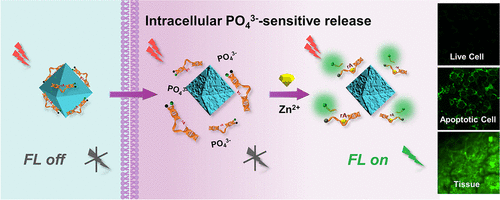Our official English website, www.x-mol.net, welcomes your
feedback! (Note: you will need to create a separate account there.)
DNAzyme-Metal-Organic Framework Two-Photon Nanoprobe for in situ Monitoring of Apoptosis-associated Zn2+ in living cells and tissues.
ACS Sensors ( IF 8.2 ) Pub Date : 2020-09-22 , DOI: 10.1021/acssensors.0c01271 Xinxin Shi 1 , Hong-Min Meng 1 , Xin Geng 1 , Lingbo Qu 1, 2 , Zhaohui Li 1, 2
ACS Sensors ( IF 8.2 ) Pub Date : 2020-09-22 , DOI: 10.1021/acssensors.0c01271 Xinxin Shi 1 , Hong-Min Meng 1 , Xin Geng 1 , Lingbo Qu 1, 2 , Zhaohui Li 1, 2
Affiliation

|
Monitoring Zn2+ in living cells is critical for fully elucidating the biological process of apoptosis. However, the quantitative intracellular sensing of Zn2+ using DNAzyme remains challenging because of issues related to penetration of the signal through tissue, targeted cellular uptake and activation, and susceptibility toward enzymatic degradation. In this study, we developed a novel phosphate ion-activated DNAzyme–metal–organic frameworks (MOFs) nanoprobe for two-photon imaging of Zn2+ in living cells and tissues. The design of this nanoprobe involved the loading of a Zn2+-specific, RNA-cleaving DNAzyme onto the MOFs through strong coordination between the phosphonate O atoms of the DNAzyme backbone and Zr atoms in the MOFs. This coordination restrained the extracellular activity of DNAzyme; however, after cell entry, the DNAzyme was released from the MOFs through a competitive binding by the phosphate ions present at a high intracellular concentration. Following their release, the two-photon (TP) fluorophore-labeled substrate strands of DNAzyme were cleaved with the aid of Zn2+, which resulted in a strong fluorescence signal. The incorporation of a TP fluorophore into the nanoprobe facilitated near-infrared excitation, which allowed the highly sensitive and specific imaging of Zn2+ in living cells and tissues at greater depths than possible previously. The TP-DNAzyme-MOFs nanoprobe achieved a low detection limit of 3.53 nM, extraordinary selectivity toward Zn2+, and a tissue signal penetration of 120 μm. More importantly, this nanoprobe was successfully used to monitor cell apoptosis, and this application of the DNAzyme-MOFs probe holds great potential for future use in biological studies and medical diagnostics.
中文翻译:

DNAzyme-金属-有机框架两光子纳米探针用于活细胞和组织中与凋亡相关的Zn2 +的原位监测。
监测活细胞中的Zn 2+对于充分阐明细胞凋亡的生物学过程至关重要。然而,由于与信号穿过组织的渗透,靶向的细胞摄取和激活以及对酶降解的敏感性有关的问题,使用DNAzyme对Zn 2+进行定量的细胞内传感仍然具有挑战性。在这项研究中,我们开发了一种新颖的磷酸离子激活的DNAzyme-金属-有机框架(MOF)纳米探针,用于活细胞和组织中Zn 2+的双光子成像。该纳米探针的设计涉及Zn 2+的负载通过在DNAzyme骨架的膦酸酯O原子与MOF中的Zr原子之间的强配位,将特定的RNA裂解DNAzyme转移到MOF上。这种协调抑制了DNAzyme的细胞外活性。然而,进入细胞后,DNAzyme通过高细胞内浓度存在的磷酸根离子的竞争性结合而从MOF中释放出来。释放后,借助Zn 2+裂解双光子(TP)荧光团标记的DNAzyme底物链,从而产生强荧光信号。在纳米探针中掺入TP荧光团可促进近红外激发,从而实现Zn 2+的高灵敏度和特异性成像在活细胞和组织中的深度比以前更大。TP-DNAzyme-MOFs纳米探针实现了3.53 nM的低检测限,对Zn 2+的超强选择性以及120μm的组织信号穿透力。更重要的是,该纳米探针已成功用于监测细胞凋亡,而DNAzyme-MOFs探针的这种应用在生物学研究和医学诊断中具有广阔的应用前景。
更新日期:2020-10-25
中文翻译:

DNAzyme-金属-有机框架两光子纳米探针用于活细胞和组织中与凋亡相关的Zn2 +的原位监测。
监测活细胞中的Zn 2+对于充分阐明细胞凋亡的生物学过程至关重要。然而,由于与信号穿过组织的渗透,靶向的细胞摄取和激活以及对酶降解的敏感性有关的问题,使用DNAzyme对Zn 2+进行定量的细胞内传感仍然具有挑战性。在这项研究中,我们开发了一种新颖的磷酸离子激活的DNAzyme-金属-有机框架(MOF)纳米探针,用于活细胞和组织中Zn 2+的双光子成像。该纳米探针的设计涉及Zn 2+的负载通过在DNAzyme骨架的膦酸酯O原子与MOF中的Zr原子之间的强配位,将特定的RNA裂解DNAzyme转移到MOF上。这种协调抑制了DNAzyme的细胞外活性。然而,进入细胞后,DNAzyme通过高细胞内浓度存在的磷酸根离子的竞争性结合而从MOF中释放出来。释放后,借助Zn 2+裂解双光子(TP)荧光团标记的DNAzyme底物链,从而产生强荧光信号。在纳米探针中掺入TP荧光团可促进近红外激发,从而实现Zn 2+的高灵敏度和特异性成像在活细胞和组织中的深度比以前更大。TP-DNAzyme-MOFs纳米探针实现了3.53 nM的低检测限,对Zn 2+的超强选择性以及120μm的组织信号穿透力。更重要的是,该纳米探针已成功用于监测细胞凋亡,而DNAzyme-MOFs探针的这种应用在生物学研究和医学诊断中具有广阔的应用前景。


















































 京公网安备 11010802027423号
京公网安备 11010802027423号